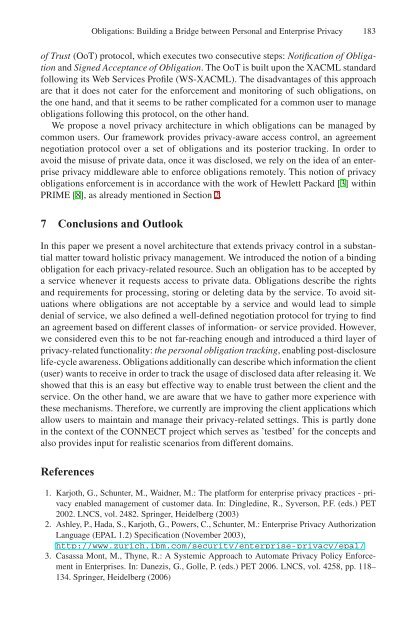Lecture Notes in Computer Science 5185
Lecture Notes in Computer Science 5185
Lecture Notes in Computer Science 5185
Create successful ePaper yourself
Turn your PDF publications into a flip-book with our unique Google optimized e-Paper software.
Obligations: Build<strong>in</strong>g a Bridge between Personal and Enterprise Privacy 183<br />
of Trust (OoT) protocol, which executes two consecutive steps: Notification of Obligation<br />
and Signed Acceptance of Obligation. The OoT is built upon the XACML standard<br />
follow<strong>in</strong>g its Web Services Profile (WS-XACML). The disadvantages of this approach<br />
are that it does not cater for the enforcement and monitor<strong>in</strong>g of such obligations, on<br />
the one hand, and that it seems to be rather complicated for a common user to manage<br />
obligations follow<strong>in</strong>g this protocol, on the other hand.<br />
We propose a novel privacy architecture <strong>in</strong> which obligations can be managed by<br />
common users. Our framework provides privacy-aware access control, an agreement<br />
negotiation protocol over a set of obligations and its posterior track<strong>in</strong>g. In order to<br />
avoid the misuse of private data, once it was disclosed, we rely on the idea of an enterprise<br />
privacy middleware able to enforce obligations remotely. This notion of privacy<br />
obligations enforcement is <strong>in</strong> accordance with the work of Hewlett Packard [3] with<strong>in</strong><br />
PRIME [8], as already mentioned <strong>in</strong> Section 2.<br />
7 Conclusions and Outlook<br />
In this paper we present a novel architecture that extends privacy control <strong>in</strong> a substantial<br />
matter toward holistic privacy management. We <strong>in</strong>troduced the notion of a b<strong>in</strong>d<strong>in</strong>g<br />
obligation for each privacy-related resource. Such an obligation has to be accepted by<br />
a service whenever it requests access to private data. Obligations describe the rights<br />
and requirements for process<strong>in</strong>g, stor<strong>in</strong>g or delet<strong>in</strong>g data by the service. To avoid situations<br />
where obligations are not acceptable by a service and would lead to simple<br />
denial of service, we also def<strong>in</strong>ed a well-def<strong>in</strong>ed negotiation protocol for try<strong>in</strong>g to f<strong>in</strong>d<br />
an agreement based on different classes of <strong>in</strong>formation- or service provided. However,<br />
we considered even this to be not far-reach<strong>in</strong>g enough and <strong>in</strong>troduced a third layer of<br />
privacy-related functionality: the personal obligation track<strong>in</strong>g, enabl<strong>in</strong>g post-disclosure<br />
life-cycle awareness. Obligations additionally can describe which <strong>in</strong>formation the client<br />
(user) wants to receive <strong>in</strong> order to track the usage of disclosed data after releas<strong>in</strong>g it. We<br />
showed that this is an easy but effective way to enable trust between the client and the<br />
service. On the other hand, we are aware that we have to gather more experience with<br />
these mechanisms. Therefore, we currently are improv<strong>in</strong>g the client applications which<br />
allow users to ma<strong>in</strong>ta<strong>in</strong> and manage their privacy-related sett<strong>in</strong>gs. This is partly done<br />
<strong>in</strong> the context of the CONNECT project which serves as ’testbed’ for the concepts and<br />
also provides <strong>in</strong>put for realistic scenarios from different doma<strong>in</strong>s.<br />
References<br />
1. Karjoth, G., Schunter, M., Waidner, M.: The platform for enterprise privacy practices - privacy<br />
enabled management of customer data. In: D<strong>in</strong>gled<strong>in</strong>e, R., Syverson, P.F. (eds.) PET<br />
2002. LNCS, vol. 2482. Spr<strong>in</strong>ger, Heidelberg (2003)<br />
2. Ashley, P., Hada, S., Karjoth, G., Powers, C., Schunter, M.: Enterprise Privacy Authorization<br />
Language (EPAL 1.2) Specification (November 2003),<br />
http://www.zurich.ibm.com/security/enterprise-privacy/epal/<br />
3. Casassa Mont, M., Thyne, R.: A Systemic Approach to Automate Privacy Policy Enforcement<br />
<strong>in</strong> Enterprises. In: Danezis, G., Golle, P. (eds.) PET 2006. LNCS, vol. 4258, pp. 118–<br />
134. Spr<strong>in</strong>ger, Heidelberg (2006)

















